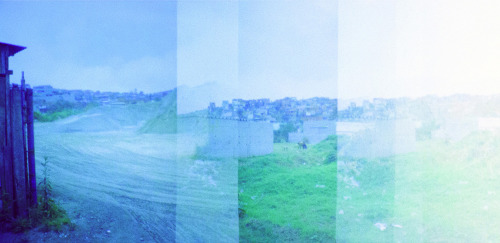
© Ilma Guideroli, ‘panorama_lotação’
The artist’s book Ilma Guideroli detects certain issues that reflect her previous production with photography and collage: the fragmented, stacked or transient spaces; the places of thought; mappings and their misrepresentations. ‘panorama_lotação’ shows us the result of recordings made from inside a minibus, a journey that lasted a few months while the artist was working in a district located in the far eastern city of São Paulo. The publication is presented as a kind of linear labyrinth, printed on both sides and allowing several folds.
In carrying out the work you use an analog camera, the negative goes through several processes before obtaining the final image. This path shows a mixture between control and chance - to make this chance visible, some planning is necessary, most of the time the process involves no real reactions, a sort of improvisation. Tell us how you captured and treated the images for the book.
Ilma Guideroli (IG): I believe that chance is present in various forms in my artistic production. In the case of ‘panorama_lotação’, I made the images using an analog plastic camera, called a Lomo. I like that kind of camera because it gives me more freedom to work in crowded places, without attracting attention - people often do not even realize that I’m photographing - and the possibility of moving the film in parts rather than a complete picture allows me to create overlaps between frames. The results are diverse, since they depend on the location, the light condition, the sensitivity of the photographic film used, how the camera is positioned and when the film is advanced manually.
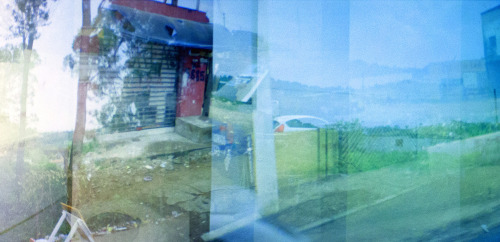
© Ilma Guideroli, ‘panorama_lotação’
After developing the negative, they pass through the scanning process. In the case of this work, instead of using a scanner, I set up an apparatus made from a shoebox and a light source, and I photographed the negatives with a digital camera . The results were images with a bluish tint (expected due to the offset) and a more diffuse light on one side of an image. I ended up incorporating this blue cast, which creates an atmosphere of strangeness, a place that does not really exist.
Michel de Certeau in his book ‘The Practice of Everyday Life’ suggests that the writer in the act of reporting reality designs and builds living spaces. «In modern Athens, the vehicles of mass transportation are called metaphorai. To go to work or come home, one takes a 'metaphor’ - a bus or a train. Stories could also take this noble name: every day, they traverse and organize places; they select and link them together; they make sentences and itineraries out of them. They are spatial trajectories.» It can be said that you perform this type of description with your images?
IG: The dynamics established from the time the book is opened are in fact related to accommodation spaces described by Michel Certeau in that there is a shuffle, sort of game, each time the images are regrouped and rearranged. But unlike a conventional game, there are rules to follow. A little bit like with a kaleidoscope, where the images provoke reflections and reverberations.
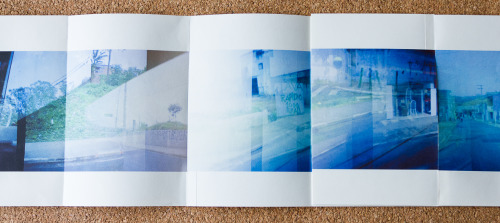
© Ilma Guideroli, ‘panorama_lotação’, Book view
Your work translates into the space / time of the image the reactivation of the experience of a course of everyday life, so it incorporates mobility as a basic feature, it belongs to the scope of the movement. It is a fruition through a stream, images appear continuously, as if you ignore the organization in frames that the opening and closing of the shutter impose. Thus no separate parts, and hence there is no hierarchy between the parts. Do you agree?
IG: The trajectories are made in order to get lost: there is no hierarchy between the official and the alternative ones, both meet and fuse with the same importance, indefinitely. If a path is determined by continuous lines, it can be influenced and / or interrupted by another line. Or, at times, a fragment determines the route in a sort of incomplete and obsolete guide, in other continuity is established in the chaos.
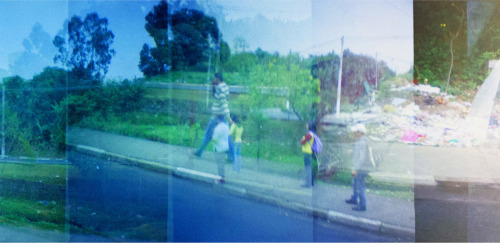
© Ilma Guideroli, ‘panorama_lotação’
Thus ‘panorama_lotação’ is not exactly a narrative because, despite being arranged in a straight line, that line can be broken and the images recombined with the book handling and the different ways to make the folds. The viewers’ actions break the flow we talked about earlier, and make the time pass to present itself as modulations. Overlays, mergers, repetitions are now open itineraries ready to be modified and reinvented, destroying the direct relationship of before and after. The book incorporates the action of transformation. When you started this work, did you have the book in mind as a final product?
IG: No. As soon as I saw the images, I began to think of them from a panoramic point of view, referring to a continuity. I thought about video, but soon realized I wanted something manipulable, on the scale of hands, and printed; the screen seemed very far and with few possibilities of interaction.
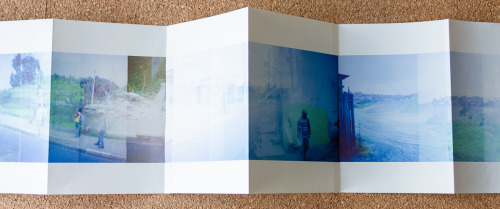
© Ilma Guideroli, ‘panorama_lotação’, Book view
But the linear format just did not give a correct account to the multiple combinations that the viewers would have at their disposal. Thus I looked for a solution that had a little of both, and the final configuration was a folded binding, the sheets were printed double-sided and folded in half; so it’s unclear where the images begin and end, and it was precisely what I sought.
There is also an inaccuracy between document and fiction in the images. In the words of artist Francis Aly; «whereas the highly rational societies of the Renaissance felt the need to create utopias, we of our times must create fables.» It is impossible to say everything about something or a place, there is always something left to learn from, and that is something that remains generating fable - which departs from the colloquial, the real… Would you say that in the book, what matters is not exactly what is being reported, but the possibility of opening a space for the construction of a fantastic universe?
IG: Yes, and over the work building process that was becoming increasingly clear. I believe there are several indications in the images that recall the imagination: the color blue that reminds the Cyanotype and creates an atmosphere that does not match reality, rather something dreamlike. Overlays, reverberations and repetitions accentuate that character. In addition there is a dynamic that complies with the changing scenes, which is directly related to my point of view, that of capturing images from a bus while following an everyday journey. So I think there are many layers overlapping not only at the moment of registration, but also concerning the negatives, scanning, printing…
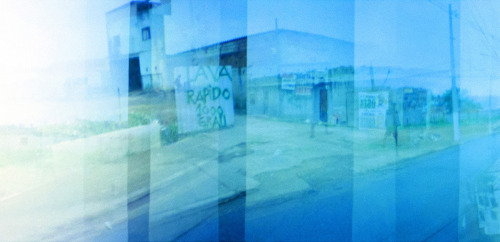
© Ilma Guideroli, ‘panorama_lotação’
This reminds me of the way Michel Foucault speaks of the mirror. For him, the mirror is a mixed experience, an unreal space that opens up virtually behind the surface as a kind of shadow and at the same time, it is something that actually exists, in the sense that it makes this place that we occupy absolutely real in relation to all the space that surrounds us. In your work, the translucent, immaterial, the ghostly, gives this sense of virtual, as if the images had no place, as if seen in a mirror. This creates an atmosphere of contact distance, however nothing is insignificant in that transparency. There is a conflict between the surface and depth. As if all we see there lives forever and at the same time, dies every moment. Something that does not end. Will you put an end point?
IG: I prefer to think of a cyclical continuity rather than an end point. And with ‘panorama_lotação’ I believe I could transpose this concept to the material. Of course there are always limitations, but often what we think as support can be rethought infinitely. My production has this cyclicality, since working with different media and supports. I have no fondness for analogue photography to digital, for example. It depends on what each project asks. I’ve had works where I started with drawing and then repercussions and layers took me to the installation, collage, and then back to the drawing. I like to face my production with a range of open and interchangeable possibilities.
---
LINKS
Ilma Guideroli | blog
Kamikaze_Publicações
Brazil
share this page